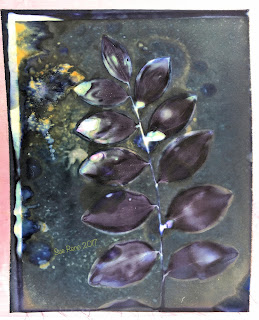I'm enjoying following the succession of blooms in my garden by making wet cyanotype prints in response. For this batch I used some hydrangea sprigs.
I removed some of the florets so that the individual petals would have more of a chance to print. I didn't want the flower to look like a blob.
I missed the calla lily blooms earlier in the summer, but the leaves are always interesting, with the little translucent windows scattered throughout.
I also tried some Japanese anemone sprigs. This plant is a favorite both in the garden and in the studio, and I've used the leaves and flowers many times before. So I was curious to see how it would print as a wet cyano image. So far I'm finding that delicate blossoms can get overcooked in the process.
Here's my Japanese Anemone quilt from a few years ago; click through to see details. For this one I used both fresh plants and digital images printed on transparencies.
I rounded out this group with a sprig of variegated Solomon's seal.
If you are new here, I am documenting my experiments with the wet cyanotype process in detail, and you can read the previous posts in reverse chronological order by clicking on the Wet Cyanotype tab in the top header. And for lots and lots of information and imagery, go to Instagram and search on the #wetcyan tag, where so many artists are sharing generously.
For this batch, I returned to using a spritz of diluted Dye-na-flow textile paint on the board before layering on the fabric, and that gave me the pink tones in the prints. After adding the plants, I misted everything with water, covered it with a glass plate, and set it outside to expose in the sun.The other colors and all the patterning come from the breakdown of the cyanotype chemicals during long exposures and with the added moisture.
This batch sat outside for 23 hours. The temperature topped out in the 80s (F), humidity was in the mid 50's (much lower than earlier in the summer), and the sun was bright but intermittent, with some cloudiness.
Here are the prints after exposure, and before rinsing. The pink worked out really well on this one:
All of them seemed on the dark side, with minimal, but attractive, background mottling.
As I predicted, the anemone flowers got a bit indistinct over the long exposure.
Here are the finished prints. I'm loving the colors in the hydrangea prints. (All images enlarge when clicked.)
I'm also very happy with the calla leaf.
I am making these prints on fabric, specifically cotton sateen, because they are not a finished product but rather imagery I can incorporate into art quilts and mixed media pieces. The slightly blurry flowers on this anemone print are easily fixable with stitching and/or paint and/or beadwork, so I still count this as a success.
Last but not least, the Solomon's seal print is lovely and moody, and again, has a lot of potential for further enhancement.
After years and years of making more conventional cyanotype prints, I am finding this process addictive and instructive. There are more on the way, so stayed tuned!
















3 comments:
I have been following your posts over the summer and you've got me hooked. I have done a lot of "regular" cyanotype and I just have to try this process. The ethereal quality of the prints is very appealing. Now we need a few sunny days here in central Maryland so I can start experimenting!
Looks like it's going to be a nice weekend, Sandy, enjoy!
Another great batch of print Sue! Thanks for sharing your experiments with us.
Post a Comment